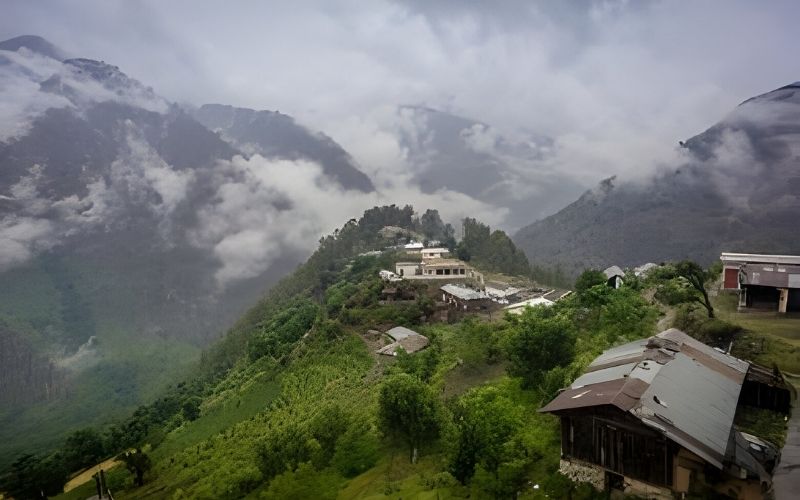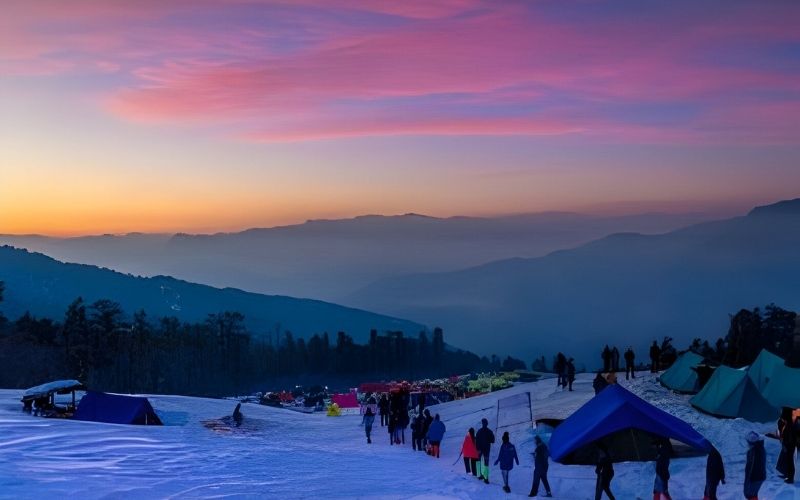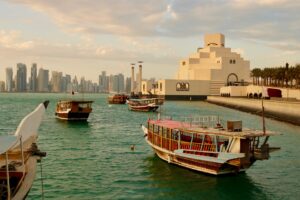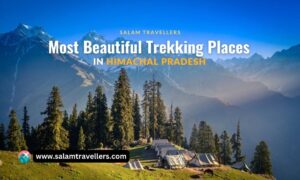
The Kedarkantha Trek is considered one of the most popular and beautiful winter treks in India. Located within the Govind Wildlife Sanctuary and National Park in the state of Uttarakhand, this trek takes you through gorgeous Himalayan landscapes and peaks.
The starting point of the Kedarkantha trek is Sankri village, which sits at an elevation of 6,400 feet (1,950 m). From Sankri, the trail winds uphill through dense forests and meadows before opening up to stunning views of snow-capped mountain vistas.
The highest point of the trek is the Kedarkantha summit, which stands tall at 12,500 feet (3,800 m) above sea level. Given the high altitude, deep snows cover the Kedarkantha peak and surroundings during winter and make for an unforgettable trekking experience.
Also read: Top 10 Treks of Uttarakhand for Summer of 2024
Best Time for the Kedarkantha Trek
The only chance and the best time to do the Kedarkantha trek journey is from December to April. This is when the weather is cold but favorable for trekking. The summer months should be avoided as the snow starts melting, which makes the trail very slushy. Monsoons are also not ideal due to the risk of landslides and very cold temperatures at the summit.
Also read: What Document Require Kashmir Trip, Ultimate Checklist
The winter months from December to February are excellent for the trek when the temperatures range from -5°C to 10°C during the day. The cold weather can make it more challenging, but the views are extremely rewarding, with snow-capped peaks all around. The nighttime temperatures can go down to -15°C, so carrying adequate warm clothing is a must.
The post-monsoon months of October and November are also good for trekking here, but there will be no snow at the summit. The average temperature during this time is around 15°C during the day.
Also read: Nag Tibba Trek
Difficulty Level
The Kedarkantha trek is considered of moderate difficulty, making it an ideal choice for beginners and those without much prior trekking experience. The trail has a gradual ascent most of the way, avoiding steep climbs. There are some sections with loose rocks and boulders to navigate, but overall, the terrain is not very technical.
As long as you are reasonably fit, acclimatize properly, and trek at a comfortable pace, you should be able to complete the Kedarkantha trek without much difficulty. The highest point reached is 12,500 feet, so some people may feel the effects of altitude, but gradual ascent over multiple days allows most trekkers to adapt.
Also read: Top 10 Treks of Karnataka for Family
Kedarkantha Trek Distance
The total trekking distance is approximately 20 km over 4 days, not counting the drive from Dehradun to Sankri and back. The trek usually takes about 5 days, including the acclimatization day. Here’s a breakdown of the daily trek distance and time taken:
- Day 1: Sankri to Juda Ka Taal – 4 km trek – 3-4 hours
- Day 2: Juda Ka Taal to Kedarkantha Base – 3 km trek – 4 hours
- Day 3: Kedarkantha Base to Kedarkantha Summit; Kedarkantha Summit to Hargaon camp – 6 km trek – 8 hours
- Day 4: Hargaon camp to Sankri via Swargarohini camp – 4 km trek – 6 hours
- Day 5: Sankri to Dehradun by road
The route has a gradual ascent and takes around 4-8 hours each day, depending on fitness levels.
Also read: Top 10 Adrenaline Pumping Things to Do in Lonavala Hill Station
Kedarkantha Trek Route
The Kedarkantha trek route passes through some beautiful Himalayan villages and campsites. Here are the major ones:
Sankri

Sankri is the starting point of the Kedarkantha trek and the last inhabited village on the route. It is situated at an altitude of 6,400 ft and has a population of around 500 people. Sankri has a few accommodation options for trekkers to spend the night before beginning the trek.
Juda Ka Talab
Juda Ka Talab is an emerald green lake located at an altitude of 9,100 ft along the Kedarkantha trek route. Trekkers camp near the lake on Day 1 of the trek after hiking around 6 km from Sankri. The campsite offers stunning views of the Himalayan peaks.
Kedarkantha Base
The Kedarkantha base camp is located at an altitude of 11,250 ft, around 16 km from Sankri. Trekkers reach the base camp on Day 2 after a steep ascent through pine forests. This is the last campsite before attempting the summit climb.
Kedarkantha Summit
At 12,500 ft, the Kedarkantha summit is the highest point of the trek. Trekkers start early on Day 3 from the base camp to conquer the summit. The climb takes around 3 hours one way. The 360-degree Himalayan panoramas from the top are breathtaking.
Also read: 7 Adventurous Things to Do in Malana This Summer
Highlights of the Trek
The Kedarkantha trek offers some spectacular highlights along the route. Trekkers get to experience:
Snow-clad Himalayan peaks
The highlight of the Kedarkantha trek is undoubtedly the views of majestic Himalayan peaks. On a clear day from the summit, you can see peaks like Swargarohini, Bandarpoonch, and Black Peak covered in snow. The sight of these towering peaks is simply breathtaking.
Trek through pine forests
A major portion of the Kedarkantha trek passes through lush pine forests. Walking through these forests with tall pine trees all around you is a rejuvenating experience. The pine-scented, fresh air energizes you.

Kedarkantha peak
At 12,500 feet, Kedarkantha Peak offers 360-degree panoramic views. You can see the entire Kedarkantha range, Har ki Doon Valley, and the Yamuna River from here. Conquering the summit after the steep climb is an accomplishment. Seeing the sun rise over the Himalayas from here is magical.
Also read: Chopta Trek
- Things to Carry
- Clothes and Shoes
- Trekking pants – quick dry and breathable
- Trekking shirts – full sleeves to protect from the sun
- Fleece jackets and warm layers – temperatures can drop at night
- Trekking shoes – waterproof with good grip
- Woolen socks – 2-3 pairs
- Gloves and woolen cap
- Thermal inners
Also read: Valley of Flowers Trek
Trekking Gear
- Backpack (40-60 kg)
- Trekking pole – helps with ascent and descent
- LED headlamp
- Water bottles – at least 1 liter capacity
- Energy bars and dry fruits
- Sunscreen and sunglasses
- Hand sanitizer and toilet paper
Also read: 8 Famous Treks in Maharashtra
Medicines and Toiletries
- Any personal medicines
- Crocin, Digene, etc. for headaches, upset stomachs
- Ointment for chafing or blisters
- Toothbrush, toothpaste, soap, etc.
Also read: Top 6 Adventurous Things to Do in East Sikkim

How to Reach
By Air
The nearest airport is Jolly Grant Airport in Dehradun, which is about 250 km from Sankri. Hire a taxi or take a bus to Sankri from there onwards.
By Rail
The closest railway station is Dehradun Railway Station, which is well-connected to major cities like Delhi. From Dehradun, you can take a taxi or bus to Sankri, which takes about 10-12 hours.
By Road
Sankri is well connected by motorable roads from Dehradun and Mussoorie. You can hire a taxi or take a bus from Dehradun or Mussoorie to reach Sankri. The drive takes about 10-12 hours. There are also shared taxis available from Dehradun and Mussoorie. Another option is to drive your own car or bike to Sankri. The route is Dehradun – Mussoorie – Purola – Mori – Netwar – Sankri.
Also read: Top 10 Things to Do in North Sikkim
Stay and Food Options
The Kedarkantha trek offers a good variety of stay options to suit different budgets and
preferences.
Accommodation Types
- Camping: Most trekkers on the Kedarkantha trek will camp in tents. Campsites are set up by the trek organizer at designated spots along the route. Tents are provided on a twin-sharing basis. Basic toilet tents are also arranged at the campsites.
- Homestays: Some villages along the trek route offer local homestay facilities. These provide an opportunity to get a taste of the local lifestyle and cuisine. Homestays have basic amenities, and you may need to share a room with other trekkers.
- Trek Huts: At some campsites, there are trek huts operated by the forest department. These offer dorm-style accommodations with shared facilities. Trek huts provide shelter from the elements.
Also read: 9 Best Adventure activities in Gulmarg
Local Food
The Garhwali cuisine from the region is simple but delicious. It involves wholesome meals prepared with local ingredients.
Staples like rajma, rice, and rotis are widely available. You can also try tasty dishes like kale, dubuk, and bhatt ki churkani.
On the trek, look out for local teas made from herbs and sweets like bal mithai and singori.
Carry plenty of fluids and high-energy snacks like dry fruits and protein bars.
Also read: 8 Things to Do in Pahalgam in the Winter
Is the Kedarkantha Trek safe?
The Kedarkantha trek is considered very safe for both beginners and moderately experienced trekkers, and here’s why:
- Well-Defined Trail: The trail is very well-defined and easy to follow. It doesn’t involve walking on precarious edges or technically difficult terrain. As long as you stay on the main trail, there is little chance of getting lost.
- No Technical Expertise Needed: No prior mountaineering experience or technical skills are required for this trek. There are no ropes or ladders involved. As long as you are reasonably fit, you can complete the trek.
- Medical Facilities Available: There are basic medical facilities available in the villages along the trail. The trekking company will also have certified trek leaders, guides, and porters who are trained in first aid and emergency procedures. Proper emergency evacuation plans are in place as well.
Also read: What to Pack for the Kashmir Trip in October
Final Assessment
So in summary, as long as you trek with a reliable organizer, follow the trail, and don’t have any major health issues, the Kedarkantha trek is considered very safe for most beginners and casual trekkers. The well-charted route and availability of medical support make this a suitable beginner-level high-altitude trek.
Stay tuned for more adventure guides from Salam Travellers.



